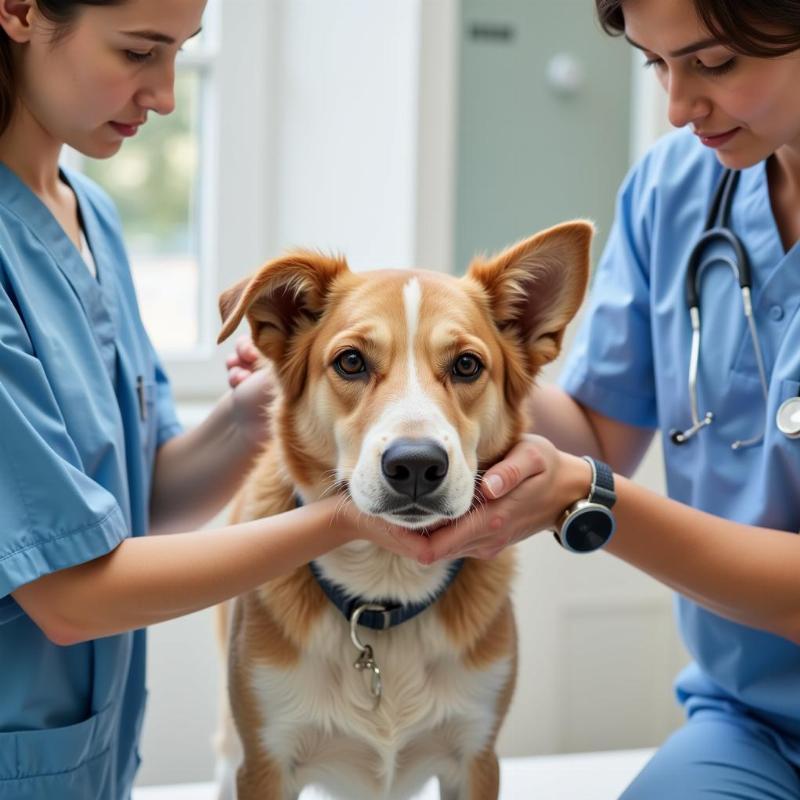Pregabalin for dogs, often sold under the brand name Lyrica, is increasingly prescribed for pain management, especially for nerve pain and seizures. While it can be effective, it’s crucial for owners to understand the potential pregabalin for dogs side effects and to work closely with their veterinarian to ensure safe and appropriate usage. This article will cover the common side effects, precautions, and essential information you need to know about pregabalin for your canine companion.
Many dog owners search for “pregabalin for dogs side effects” because they are understandably concerned about their pet’s well-being. It’s vital to be informed about potential adverse reactions and how to minimize risks. This includes understanding proper dosage, recognizing signs of an overdose, and knowing when to contact your vet. This comprehensive guide will address these concerns and provide valuable insights for responsible pet owners in the United States.
Understanding Pregabalin and its Uses in Dogs
Pregabalin works by affecting the way nerve signals that cause pain are transmitted in the brain. It is frequently used to treat conditions such as:
- Neuropathic Pain: This type of pain originates from nerve damage or dysfunction and can be challenging to manage.
- Osteoarthritis Pain: While not its primary use, pregabalin can be used in conjunction with other medications to manage the pain associated with osteoarthritis.
- Seizure Control: Pregabalin can help reduce the frequency and severity of seizures in dogs, often as an add-on therapy to other anticonvulsants.
Common Pregabalin for Dogs Side Effects
While generally well-tolerated, pregabalin can cause some side effects in dogs. These can range from mild to severe and may include:
- Sedation/Drowsiness: This is the most common side effect and is often dose-dependent.
- Ataxia (Loss of Coordination): Dogs may appear wobbly or uncoordinated, particularly at higher doses.
- Increased Appetite: Some dogs experience increased hunger while on pregabalin.
- Weight Gain: This can occur due to the increased appetite and reduced activity levels associated with sedation.
- Changes in Behavior: Some dogs may exhibit changes in personality or behavior, such as increased anxiety or aggression.
Precautions and Important Considerations
Before starting your dog on pregabalin, discuss the following with your veterinarian:
- Underlying Health Conditions: Pregabalin can interact with other medications and may not be suitable for dogs with certain health problems, such as kidney or liver disease.
- Breeding Dogs: Pregabalin is not recommended for pregnant or lactating dogs.
- Dosage: The correct dosage is crucial to minimize side effects and maximize effectiveness. Your vet will determine the appropriate dose based on your dog’s weight, condition, and other factors.
Recognizing an Overdose
An overdose of pregabalin can be serious. Signs of an overdose can include:
- Severe Sedation: The dog may be unresponsive or difficult to rouse.
- Difficulty Breathing: Respiratory depression can be a life-threatening complication.
- Tremors or Seizures: Paradoxically, an overdose can sometimes trigger seizures.
If you suspect your dog has overdosed on pregabalin, contact your veterinarian or an emergency animal hospital immediately.
 Veterinarian Examining a Dog
Veterinarian Examining a Dog
What to Do if You Observe Side Effects
If your dog experiences any side effects while taking pregabalin, contact your veterinarian. They may adjust the dosage or switch to a different medication. Never discontinue pregabalin abruptly, as this can lead to withdrawal symptoms.
Conclusion
Pregabalin can be a valuable medication for managing pain and seizures in dogs. However, it’s essential to be aware of the potential pregabalin for dogs side effects and to work closely with your veterinarian to ensure safe and effective use. By understanding the risks and benefits, you can help your furry friend live a more comfortable and happy life.
FAQ
- How long does it take for pregabalin to work in dogs? Pregabalin typically begins to work within 1-2 hours after administration.
- Can pregabalin be given with food? Yes, pregabalin can be given with or without food.
- What should I do if I miss a dose? Give the missed dose as soon as you remember, unless it’s almost time for the next dose. Do not double up on doses.
- Are there any long-term side effects of pregabalin in dogs? Long-term side effects are rare but can include weight gain and changes in liver enzyme levels. Regular monitoring by your veterinarian is essential.
- Can pregabalin be used in cats? Yes, pregabalin can be used in cats, but the dosage and precautions are different. Consult with your veterinarian for more information.
- Is pregabalin addictive for dogs? While physical dependence can develop, addiction (psychological dependence) is less common in dogs.
- What are the alternatives to pregabalin for pain management in dogs? Alternatives include gabapentin, amantadine, and NSAIDs. Your veterinarian can help determine the best option for your dog.
Related Articles
About Beautdogs.us
Beautdogs.us is your premier online resource for all things dog-related in the United States. We offer expert advice on dog breeds, care, and product recommendations, catering to both new and experienced dog owners. Our team of veterinary experts and content strategists are dedicated to providing reliable, comprehensive, and engaging information to help you navigate the joys and challenges of dog ownership. Contact us for personalized support at [email protected] or call us at +1 501-555-7529. Visit Beautdogs.us today to learn more!